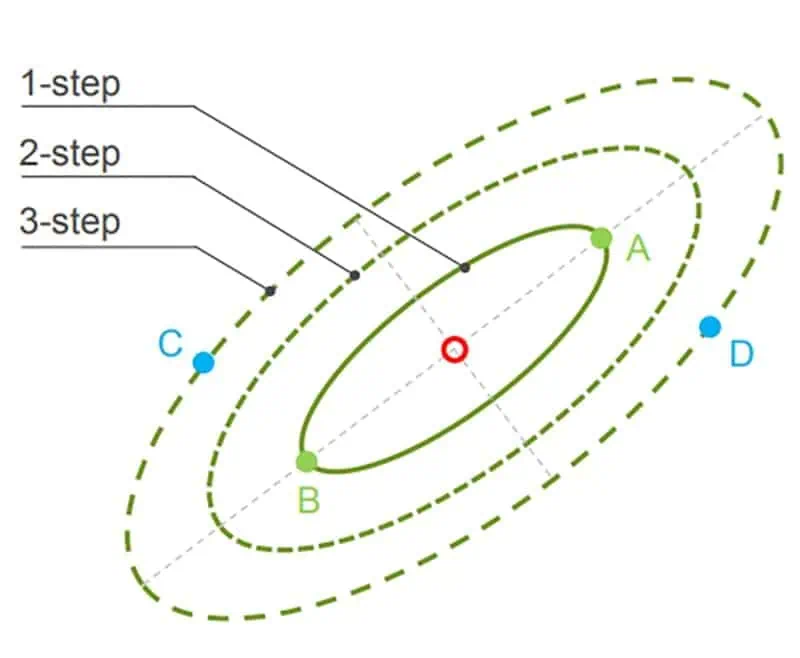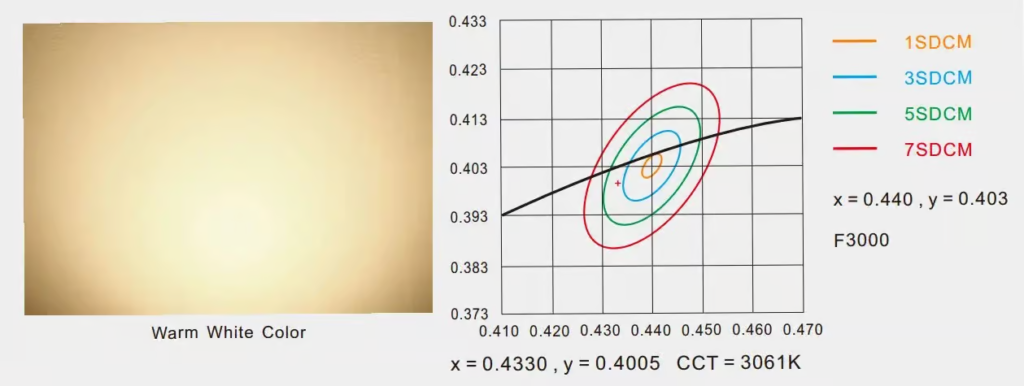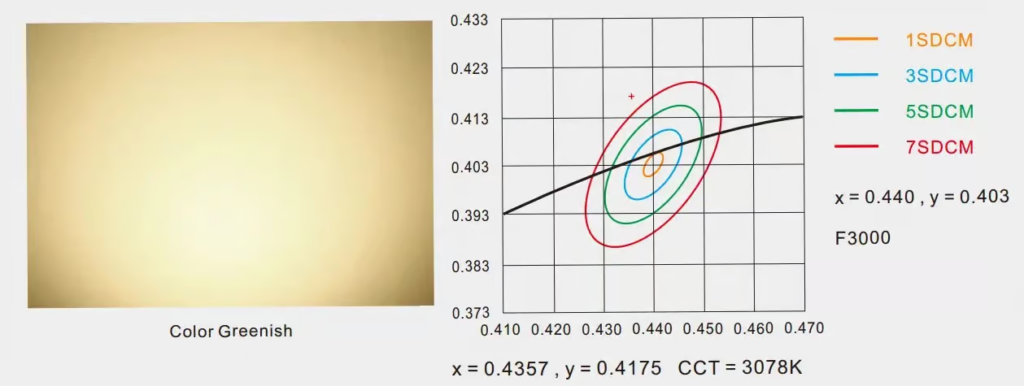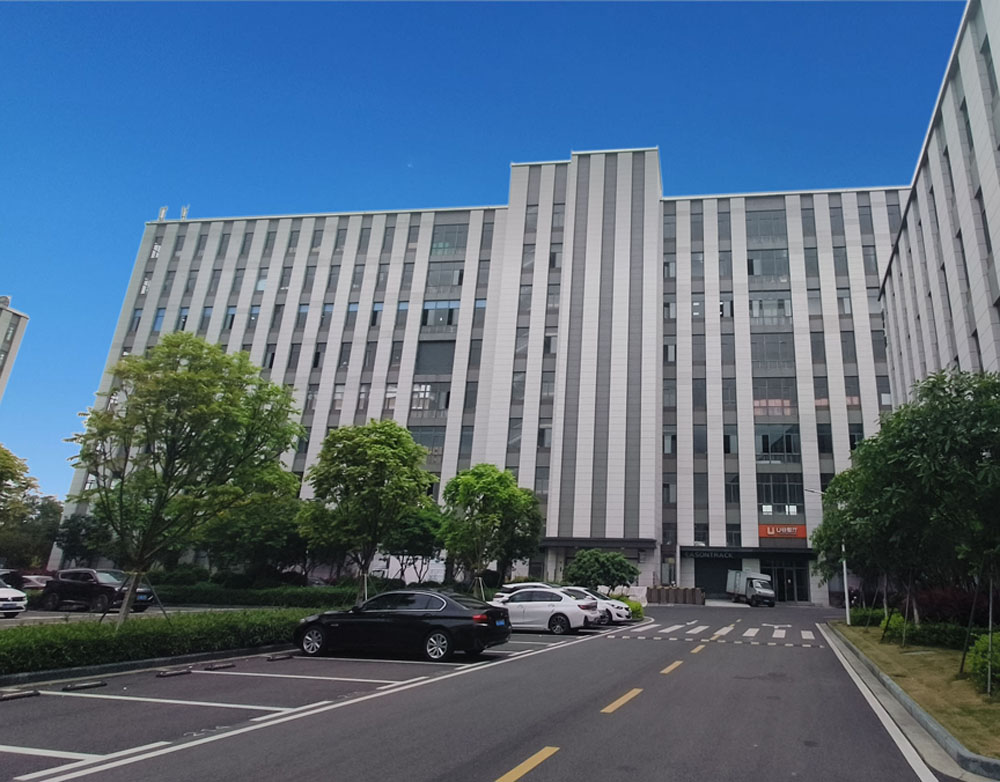When selecting dimmable downlights for your space, understanding the concept of Standard Deviation Colour Matching (SDCM) is crucial. In 2025, as lighting technology continues to evolve, SDCM has become a key factor in ensuring color consistency and quality in LED lighting. This article delves into what SDCM means, why it matters, and how it impacts your lighting choices, along with practical tips for selecting the best dimmable downlights for your needs.
What is SDCM?
SDCM stands for Standard Deviation Colour Matching, a metric that quantifies color consistency in LED lighting. It is derived from the MacAdam ellipse concept, which measures how much color variation can occur before it becomes noticeable to the human eye. Each ellipse represents a range of acceptable color variations around a target hue.
1 SDCM: No visible color difference.
2-3 SDCM: Minimal color difference, generally acceptable for most applications.
4+ SDCM: Noticeable color differences that may affect aesthetic appeal.
| MacAdam ellipse (SDCM) | Visibility |
| 1 SDCM | Almost no visible deviations |
| 2 SDCM | Deviations are visible only with instruments |
| 3 SDCM | Few deviations visible with the human eye |
| 4 SDCM | Visible deviations |
| 5 SDCM | Strongly visible deviation |
For most indoor environments, a rating of 2-3 SDCM is ideal, while 5 SDCM is typically acceptable for outdoor applications. According to industry experts, using LEDs with lower SDCM values ensures a more uniform light output and enhances the overall visual experience.

The Science Behind SDCM
To fully appreciate the significance of SDCM (Standard Deviation of Color Matching), it is essential to delve into the science of color perception. The human eye possesses a remarkable ability to detect subtle variations in color, which can profoundly influence how we interpret and experience our environment. This sensitivity to color is not merely a matter of aesthetics; it plays a critical role in our daily interactions, decision-making processes, and even emotional responses.
One of the key methods used to analyze color differences is the MacAdam ellipse method. This approach categorizes colors based on their proximity to a target hue, illustrating how closely related colors can be perceived. Within this framework, colors that lie closer together within the ellipse are less likely to be distinguished as different by the human eye. Conversely, colors that fall outside this proximity may be perceived as distinctly separate, leading to potential confusion or misinterpretation.
This scientific foundation underscores the importance of selecting dimmable downlights with low SDCM values. In practical terms, low SDCM values indicate that the light source produces colors that are more consistent and true to their intended appearance. For instance, in a retail setting where accurate product display is paramount, utilizing lighting with high SDCM values can significantly distort colors and misrepresent merchandise. Such discrepancies can lead to customer dissatisfaction, as shoppers may feel deceived by the appearance of products under artificial lighting.
Moreover, this misrepresentation can have broader implications for businesses. When customers perceive that a downlight does not match its advertised color or quality due to poor lighting conditions, they may choose not to make a purchase or may return items after realizing the discrepancy. This not only impacts immediate sales but can also harm a brand’s reputation over time. Consistent and accurate color representation fosters trust and confidence among consumers, ultimately contributing to customer loyalty and repeat business.
Why is SDCM Important?
The significance of SDCM (Standard Deviation of Color Matching) cannot be overstated, especially in environments where multiple light sources are utilized in close proximity. This is particularly true for spaces such as kitchens, offices, and retail environments, where the interplay of light can dramatically influence both functionality and aesthetics.
The Need for Color Consistency
In these settings, maintaining color consistency is not just a matter of preference; it is essential for creating an inviting and harmonious atmosphere. Variations in color temperature and hue can lead to an undesirable lighting effect that may confuse or disorient occupants. For instance, in a kitchen, inconsistent kitchen lighting can affect the way food appears, potentially impacting the cooking experience. Similarly, in retail spaces, differing light colors can alter the perception of products, ultimately influencing purchasing decisions.
Impact on Design Aesthetic
Moreover, discrepancies in color can distract from the intended design aesthetic. A well-designed space relies on a cohesive visual experience, and when lighting fails to match or complement other elements within that space, it can undermine the overall impact. This inconsistency can make a carefully curated environment feel chaotic or poorly thought out.
Key Reasons to Consider SDCM:
Visual Comfort: Maintaining consistent lighting levels is key to reducing eye fatigue and cultivating a more inviting ambiance. Research has demonstrated that environments equipped with uniform lighting significantly boost focus and overall productivity, making it an essential consideration for modern workplaces. By minimizing strain on the eyes, consistent lighting contributes to a more comfortable and efficient work environment.
Design Cohesion: Uniform illumination plays a vital role in enhancing the visual appeal of interior spaces, ensuring that colors appear authentic and vibrant. This is particularly important in interior design projects, where color mismatches can disrupt a carefully planned aesthetic and detract from the overall harmony of the space. Consistent lighting ensures that the intended color palette is accurately represented, resulting in a more cohesive and visually pleasing environment.
Product Quality: The SDCM (Standard Deviation of Color Matching) rating serves as an indicator of the quality and consistency of light emitted by a fixture. Lower SDCM ratings often signify superior manufacturing processes and the utilization of high-quality materials. Investing in lighting fixtures from reputable brands can guarantee long-term reliability and consistent performance, offering peace of mind and minimizing the need for frequent replacements.
Energy Efficiency: Dimmable downlight solutions that preserve a consistent color temperature across their full range of brightness settings offer a valuable means of achieving energy savings without sacrificing the quality of light. By allowing users to easily adjust the intensity of the lighting to suit their needs, these systems can reduce energy consumption while maintaining a visually comfortable and appealing environment. This combination of energy efficiency and quality makes dimmable lights an ideal choice for environmentally conscious consumers and businesses.


Real-World Applications
Consider a restaurant setting where ambiance is key. If the downlights have varying color temperatures due to high SDCM values, it could disrupt the dining experience. Customers may perceive food differently under inconsistent lighting, potentially impacting their overall satisfaction.
In retail environments, accurate color representation is vital for product display. For example, clothing stores rely on consistent lighting to ensure that fabrics appear true to their actual colors under various conditions. A high SDCM value could lead to discrepancies between how items look in-store compared to how they appear at home.
Choosing Dimmable Downlights with Optimal SDCM
When shopping for dimmable downlights, look for products that specify their SDCM ratings. Here are some tips:
1. Check Specifications
Always review product specifications for SDCM ratings. Aim for fixtures with 2-3 SDCM for best results. Manufacturers often provide this information on their websites or product packaging.
2. Consider Brand Reputation
Established brands often provide more reliable products with consistent performance metrics. Researching brands known for their quality control can save you time and money in the long run.
3. Test Before You Buy
If possible, see the lights in action before making a purchase. Many retailers offer display models to help you assess color consistency. Visiting showrooms or attending trade shows can provide valuable insights into how different fixtures perform under various conditions.
4. Seek Professional Advice
Consult with lighting professionals or interior designers who understand the nuances of lighting technology and can guide you in making informed choices. Professionals can help you select fixtures that not only meet your aesthetic preferences but also align with functional requirements.
5. Understand Dimming Technology
Different dimming technologies (such as TRIAC or 0-10V) can affect how well your lights maintain their color consistency when dimmed. Research which technology works best with your chosen fixtures to ensure optimal performance across all brightness levels.
The Impact of Color Temperature on SDCM
Color temperature plays a significant role in how we perceive light quality and ambiance within a space. Measured in Kelvin (K), color temperature describes whether light appears warm (yellowish) or cool (bluish). Common ranges include:
Warm White (2700K – 3000K): Creates a cozy atmosphere; ideal for residential settings.
Neutral White (3500K – 4100K): Offers balanced illumination; suitable for offices and retail spaces.
Cool White (5000K – 6500K): Mimics daylight; often used in commercial applications where clarity is essential.
| CCT | Light Color |
| 2700K | Extra Warm white |
| 3000K | Warm white |
| 4000K | Daylight white |
| 5000K | Neutral White |
| 5700K and above | Cool white |
When selecting dimmable downlights, consider how color temperature interacts with SDCM values:
Lower Color Temperatures: Typically exhibit higher consistency within lower SDCM ranges.
Higher Color Temperatures: May present more challenges due to potential variations across different manufacturers or product lines.
Understanding these dynamics will help you choose LED lights that not only fit your style but also meet performance expectations.
Trends in Dimmable Downlight Technology
As we progress through 2025, several trends are shaping the future of dimmable downlights:
Smart Lighting Integration
Smart home technology continues to gain traction, allowing users to control their lighting via smartphones or voice commands. Many modern dimmable downlights now come equipped with smart features that enable users to adjust brightness levels and even change color temperatures based on mood or time of day.
Enhanced Energy Efficiency
With increasing awareness around sustainability, manufacturers are focusing on creating energy-efficient products that consume less power while providing superior performance. Look for ENERGY STAR-rated products that guarantee both energy savings and quality assurance.
Customization Options
Consumers are increasingly seeking customizable solutions tailored to their specific needs and preferences. Manufacturers are responding by offering adjustable downlights that allow users to change beam angles or swap out lenses for different effects.

The Impact of Color Temperature on SDCM
Color temperature plays a significant role in how we perceive light quality and ambiance within a space. Measured in Kelvin (K), color temperature describes whether light appears warm (yellowish) or cool (bluish). Common ranges include:
Warm White (2700K – 3000K): Creates a cozy atmosphere; ideal for residential settings.
Neutral White (3500K – 4100K): Offers balanced illumination; suitable for offices and retail spaces.
Cool White (5000K – 6500K): Mimics daylight; often used in commercial applications where clarity is essential.
| CCT | Light Color |
| 2700K | Extra Warm white |
| 3000K | Warm white |
| 4000K | Daylight white |
| 5000K | Neutral White |
| 5700K and above | Cool white |
When selecting dimmable downlights, consider how color temperature interacts with SDCM values:
Lower Color Temperatures: Typically exhibit higher consistency within lower SDCM ranges.
Higher Color Temperatures: May present more challenges due to potential variations across different manufacturers or product lines.
Understanding these dynamics will help you choose fixtures that not only fit your style but also meet performance expectations.
Trends in Dimmable Downlight Technology
As we progress through 2025, several trends are shaping the future of dimmable downlights:
Smart Lighting Integration
Smart home technology continues to gain traction, allowing users to control their lighting via smartphones or voice commands. Many modern dimmable downlights now come equipped with smart features that enable users to adjust brightness levels and even change color temperatures based on mood or time of day.
Enhanced Energy Efficiency
With increasing awareness around sustainability, manufacturers are focusing on creating energy-efficient products that consume less power while providing superior performance. Look for ENERGY STAR-rated products that guarantee both energy savings and quality assurance.
Customization Options
Consumers are increasingly seeking customizable solutions tailored to their specific needs and preferences. Manufacturers are responding by offering adjustable fixtures that allow users to change beam angles or swap out lenses for different effects.

Radians Dimmable Downlight with Low SDCM
Radians is a prominent manufacturer specializing in the production of dimmable downlights, a key component in modern indoor lighting solutions. Our commitment to quality and innovation has allowed us to establish a strong presence in the European market, where our products are exported to several countries, including Germany, the Netherlands, and Sweden. We take great pride in meeting the high standards set by our clients in these regions, particularly when it comes to SDCM (Standard Deviation of Color Matching). For instance, our lamps destined for Germany typically maintain an SDCM of less than 5, while those exported to Northern Europe adhere to even more stringent requirements, with an SDCM of 3.
Radians Manufacturing Facility
Located in the bustling city of Foshan, Radians operates an expansive 3,000 square meter lighting manufacturing facility. This state-of-the-art plant is equipped with the latest technology and machinery, enabling us to produce high-quality lighting solutions efficiently. Our focus on innovation ensures that we stay ahead of industry trends and continuously improve our product offerings. We understand that lighting is not just about functionality; it also plays a crucial role in enhancing the aesthetics of any space.
Radians Product Range
At Radians, we specialize in a diverse range of indoor lighting solutions designed to meet various customer needs. Our product lineup includes:
- Downlights: Perfect for creating ambient lighting in residential and commercial spaces.
- Track Lights: Versatile lighting options that allow for adjustable illumination in galleries, retail stores, and exhibition spaces.
- Panel Lights: Sleek and modern fixtures that provide uniform lighting for offices and public areas.
Each product is crafted with precision and attention to detail, ensuring that we deliver exceptional performance and longevity.
Research and Development
Our dedicated research and development team plays a pivotal role in our success. They work closely with clients to understand their specific requirements and collaborate on designing advanced lighting products tailored to their needs. This partnership approach allows us to innovate continuously and develop solutions that not only meet but exceed customer expectations.
Comprehensive Professional Services
In addition to our manufacturing capabilities, Radians offers comprehensive professional services that guide clients through every stage of the process—from initial concept development to final delivery. We believe that understanding our clients’ unique needs is essential for providing tailored solutions. Our team is committed to offering inventive approaches that enhance the overall experience and satisfaction of our customers.
Commitment to Quality and Customer Satisfaction
At Radians, quality is at the forefront of everything we do. We adhere to strict quality control measures throughout the manufacturing process to ensure that every product meets our high standards. Our customer service team is always available to address inquiries or concerns, providing support and guidance whenever needed.
Get in Touch
If you would like to learn more about Radians, our innovative products, or how we can assist you with your lighting needs, please do not hesitate to contact our customer service team. We are here to help you illuminate your spaces with our exceptional lighting solutions!

Conclusion
Understanding SDCM is vital when selecting dimmable downlights for any space. By prioritizing low SDCM values and considering factors like color temperature and technological advancements, you ensure that your lighting not only meets functional needs but also enhances the aesthetic quality of your environment.




